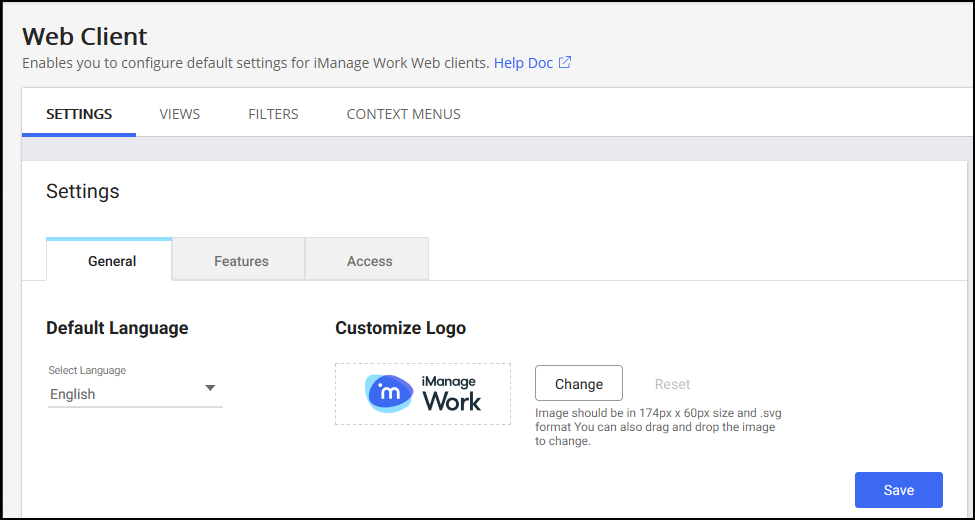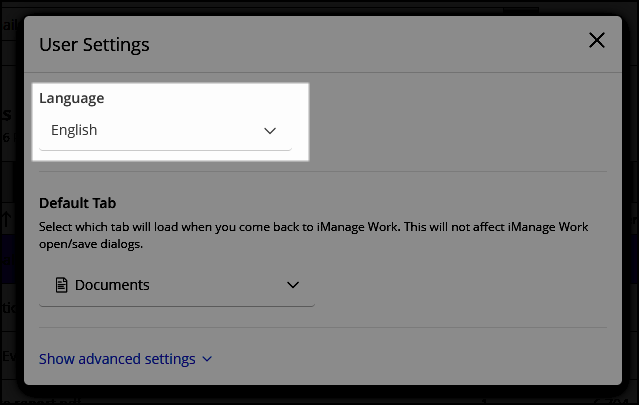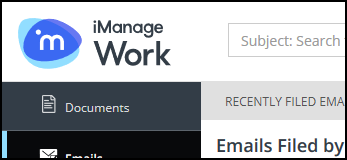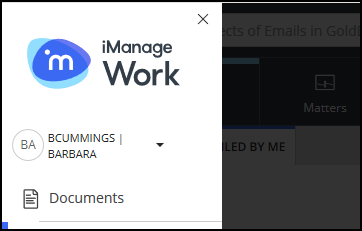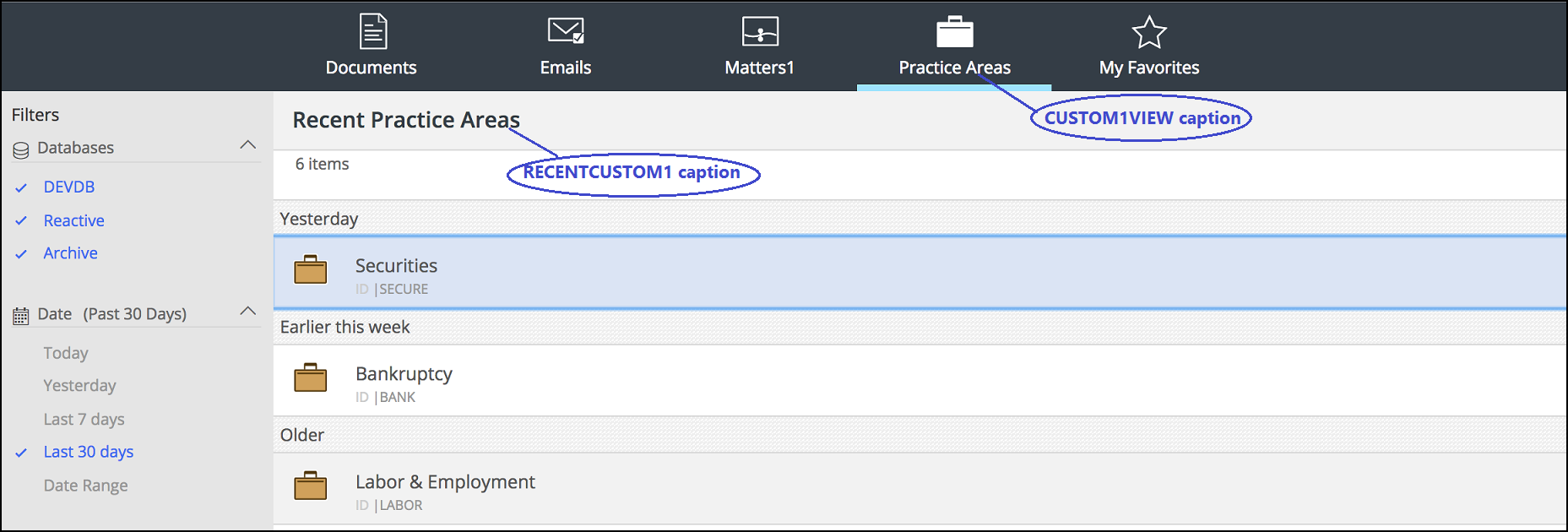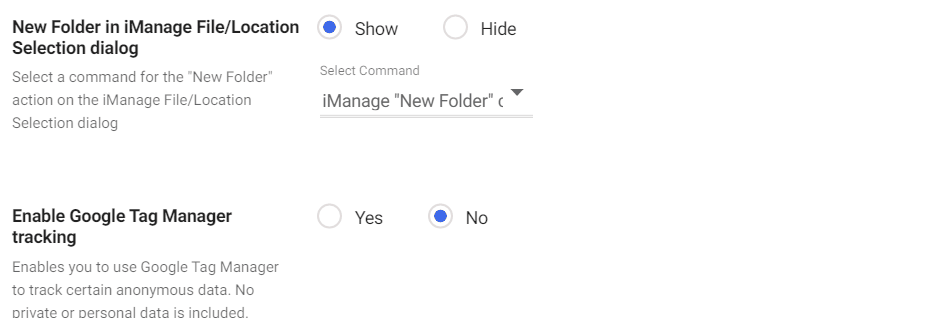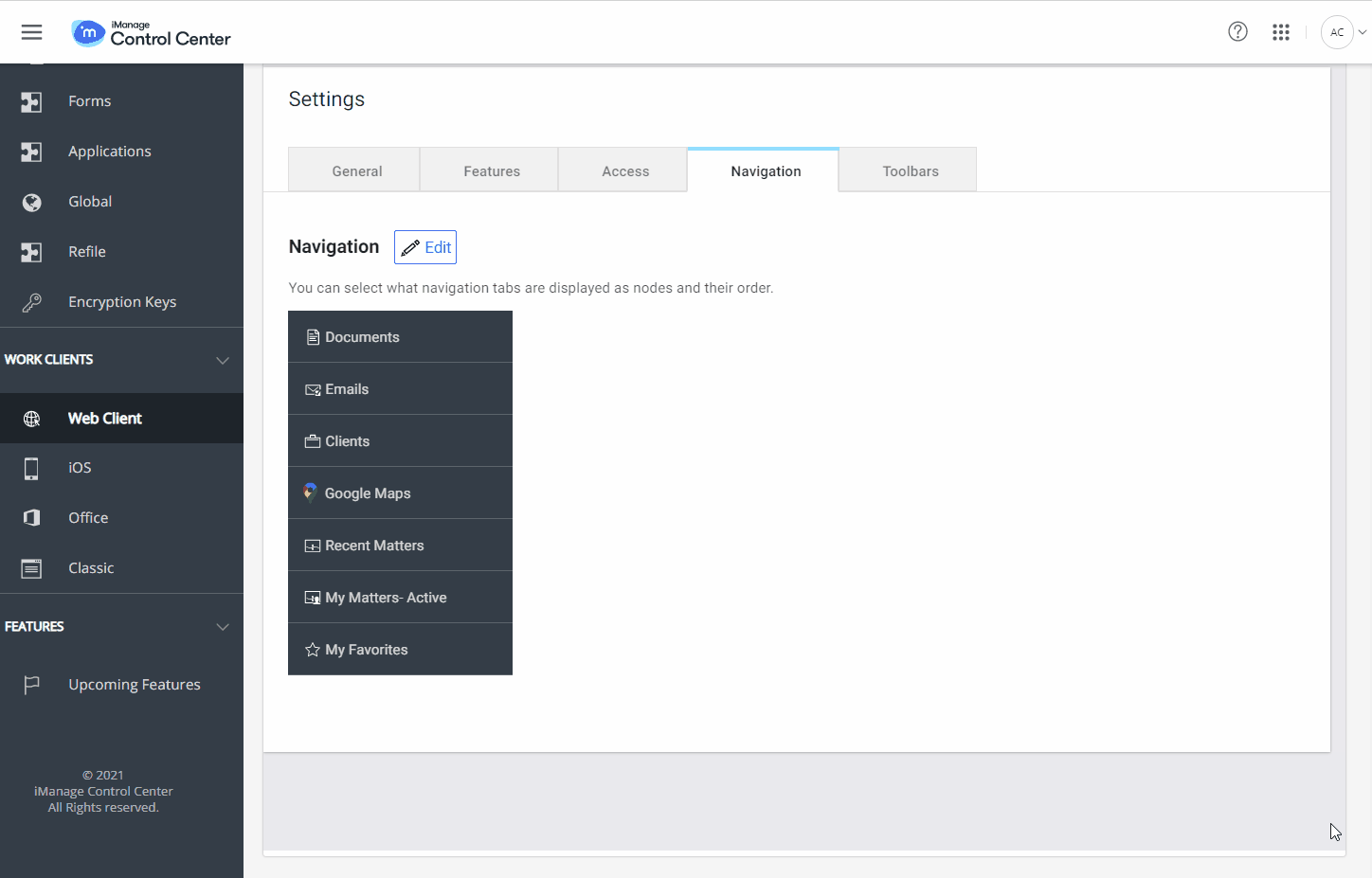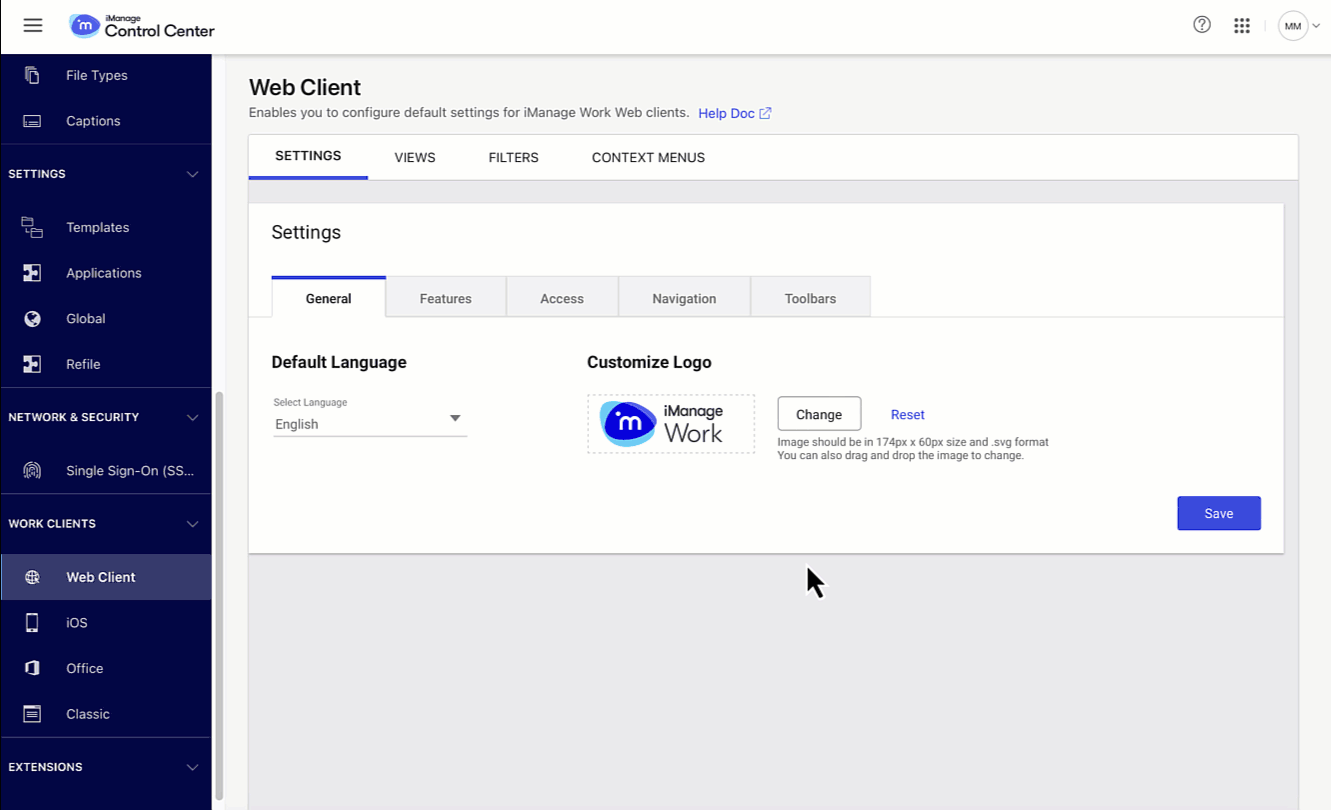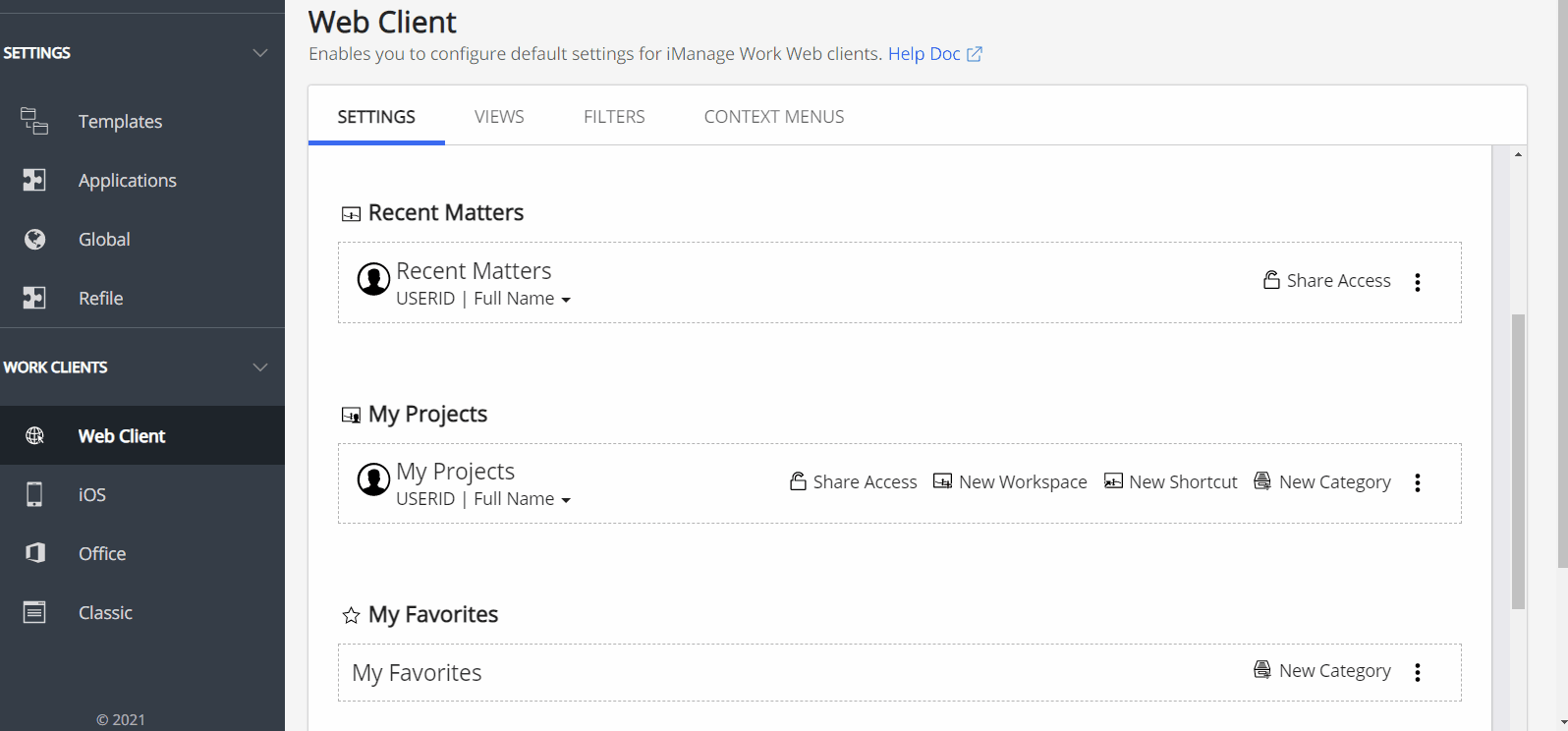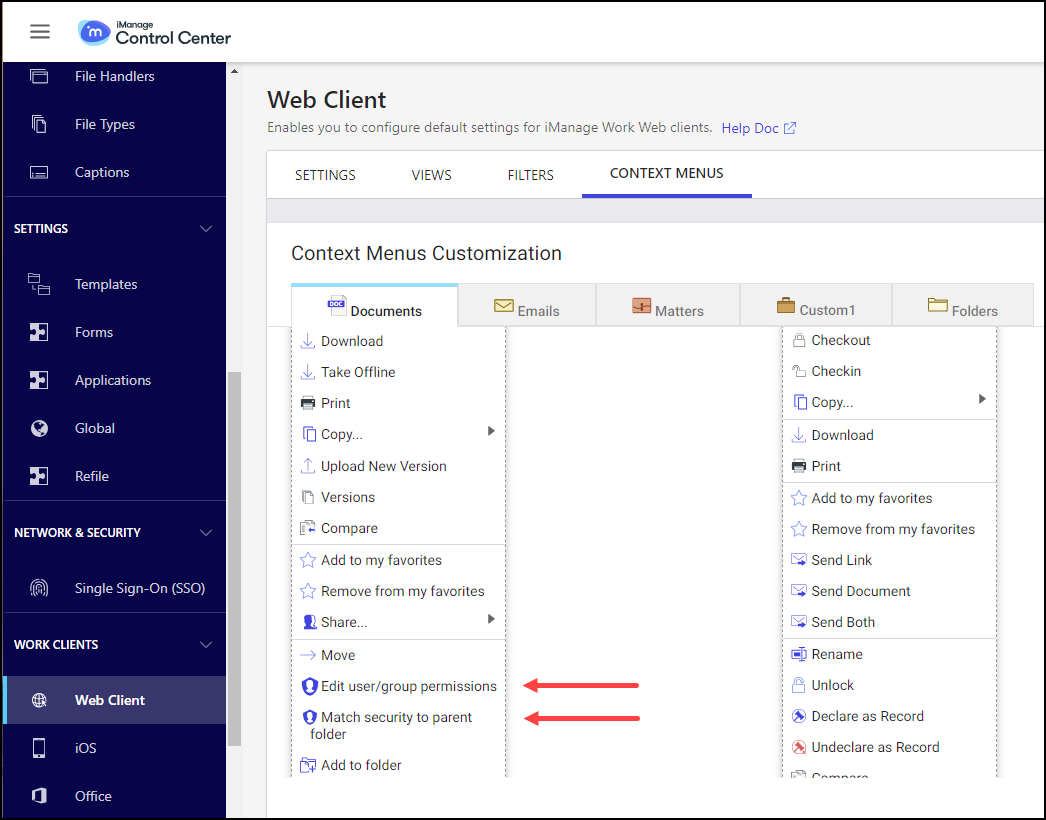NOTE: To perform operations on the Web Client page, the user must be a member of the NRTADMIN group, or be assigned to a role with Tier 2 access to Control Center. For more information about the specific operations allowed, refer to Understanding tiers.
Access the Web Client settings page by navigating in Control Center to Work Clients > Web Client > Settings.
The Settings page contains the following tabs:
General: Configure general iManage Work 10 Web settings.
Features: Customize different feature options for the iManage Work 10 Web.
Access: Define which groups can sign in to iManage Work 10 Web.
Navigation: Select what navigation tabs are displayed as nodes and their order in iManage Work 10.
Toolbars: Configure or customize actions for containers like Recent Matters, My Matters, Workspace, Folder and so on, in iManage Work 10.
Configure general settings
To configure general settings for iManage Work 10 Web, browse to the General tab.
Set the default language for iManage Work applications using the Default Language option.
Hide specific languages by following these steps.
Customize your organization's logo for iManage Work applications using the Customize Logo option.
Setting the default language
To set the default language to be displayed when users open iManage Work or iManage Control Center in their browser, select the desired language from the Default Language drop-down list, and then select Save.
Refresh the page in your browser to display the selected language in iManage Control Center.
Individual users may also change their default language in iManage Work Web in the User Settings dialog by setting the Language option. This change applies only to their account and applies wherever they sign in to iManage Work.
Hiding a specific language from browsers
Create a new file:
C:\Program Files\Autonomy\WorkSite\WorkWebServer\settings.pyAdd the following contents to the file, excluding any languages you don’t want:
|
Customizing the logo
This section describes how to customize or change the logo displayed in iManage Work. The logo appears in iManage Work at the following places:
Page headers (desktop view)
Left sidebar (mobile view)
Custom logo file requirements
The image must be in SVG format. You can't upload an image in any other format such as JPG, PNG, GIF and so on.
The image size should be 174px x 60px. If the size of your image doesn't match, it'll be scaled to 174px x 60 px automatically. However, the logo may appear distorted.
The SVG files exported from tools such as Adobe Illustrator or Sketch work properly without any additional effort. However, if the logo doesn't appear in the UI, open the image file in a text editor to view its
XMLformat. Verify that the <svg> element has bothxmlnsandxmlns:xlinkattributes set. If these attributes are missing, the logo may not render.
For example,<svg xmlns="http://www.w3.org/2000/svg" xmlns:xlink="http://www.w3.org/1999/xlink" … > …. </svg>
To change the logo:
In iManage Control Center, browse to Work Clients > Web Client.
On the General tab, locate the Customize Logo option and select Change.
Figure: SettingsIn the File Upload dialog, locate and select the new logo. Select Open.
Alternatively, you can drag and drop the new logo into the Customize Logo area in your browser.Select Save to apply the new logo.
Select Reset to restore the default iManage Work logo.
Configure Work Web features
To configure Work Web features, browse to the Features tab.
Customize any of the following Work 10 features, then select Save.
NOTE: Based on your iManage Work environment, changes to these settings will become visible to end users after approximately 5 minutes and upon their next login session.
Table: Feature options
Option | Steps/description |
|---|---|
Username Format | Select the format of username to be displayed in iManage Work. |
Metadata Format | Select Alias & Description or Description Only or both as the format for custom metadata fields to be displayed in iManage Work. |
Enable additional tab | Enables and configures an additional tab on the iManage Work home page. By default, this setting is disabled. When enabled, the additional tab displays a list of clients based on the user's recent activity. It is populated using the Custom1 metadata field. You can also choose a different metadata field between Custom1-12 and Custom29-30. This setting is enforced over the legacy registry setting "Custom View Metadata Field". Select Yes to add an additional tab, then select the metadata from the drop-down list. Optionally, select METADATA > Captions, and update the captions for Figure: iManage Work Home Page Figure: iManage Work Search Window |
Default tab on login | Select which tab is loaded when users sign in to iManage Work. If not set, the Documents tab is displayed by default. Users can overwrite this preference and set their Web Default Tab in their User Settings. Figure: Default tab displayed on login |
Use Control Center forms property order | In iManage Control Center 10.5 and later, the Forms page lets administrators customize the properties displayed in iManage Work Web. By adding or removing specific properties for workspaces, folders, searches, and documents and emails in iManage Work, users can view and update this information to make it more relevant. This setting controls if the order in which you configure these properties on the Forms page is honored within iManage Work Web.
This setting lets you choose whether you want the order to be honored in iManage Work Web, giving your organization some time to train your users before turning this feature on. |
Lookup field dropdown limit | Configures the number of suggestions shown in the dropdown of lookup fields. The default is 150 suggestions. |
Allow users to perform bulk security updates | Allows iManage Work users to perform bulk security updates for documents, emails, workspaces, and folders. For additional information, refer to Enabling bulk security actions. |
New Folder in iManage File/Location Selection Dialog | Allows you to show or hide the option to create a New Folder or choose a custom command to create a New Folder in the iManage File/Location Selection dialog. The default command for creating New Folder is iManage "New Folder" command. Figure: Customized workflow for creating New Folder |
Enable Work 10 Desktop for Windows Auto Updates App Banner | Select the Windows check box if you want your end-users to see the following Enable Work 10 Desktop for Windows Auto Updates App Banner in the iManage Work application (Work Web client). By default, this check box isn't selected. Only those users who don't have iManage Work Desktop for Windows will see this banner. Figure: iManage Auto Updates Banner |
Internet Explorer Warning Message | The first time a user signs in to Work 10 using Internet Explorer, display a banner recommending use of a fully supported browser.
Figure: Internet Explorer message Refer to the List of limitations applicable to Microsoft browsers for more information. |
Enable Search Language Selection | Configures whether the language search selection option is visible for simple and advanced searches in iManage Work.
Figure: Language search selection option (when enabled) |
Title-click operation for files | Configures the default action when a user clicks the title of a document or email. This option applies to iManage Work in a Desktop browser, iManage Work panel in Outlook, and Work Desktop for Mac. NOTE: This setting is not respected when using iManage Work in a mobile browser.
The Edit/Open option should only be used if all your users have iManage Work Desktop for Windows or iManage Work for Mac installed. If this software is not available on users' machines, the the following message will be displayed: "You need to install iManage Office Integration to edit this document." The Open in Protected Mode option is not currently supported for iManage Work Desktop for Mac. When this option is selected, the title-click action defaults to the Edit/Open functionality. |
Enable web-based email sending | Disables the ability for users to send documents and links directly through the web client's email service for users who do not have iManage Work Desktop for Windows or iManage Work Desktop for Mac clients installed on their computer. This helps administrators safeguard their users from using a non-secure SMTP protocol to share documents and links externally.
|
Configure access settings
To define which groups can sign in to iManage Work 10 Web, browse to the Access tab.
The users who are not in this list can still access iManage Work using Work Desktop for Windows, Work Desktop for Mac, Work Mobility, and iManage Work classic clients.
This feature is useful for firms who decide to provide the mobile access of iManage Work client application only to specific users, and control the data that is left on the devices. For example, mobile access is provided only to partners and attorneys, while the document support staff and secretaries are restricted.
Select Yes to define which groups are allowed access to iManage Work. The field to search for groups appears.
Enter the name of the group to be added, and select Add to provide access to the group.
Select X to remove the group that has already been added.
Select No to prevent access to iManage Work for any users.
Select Save.
Configure navigation settings
To configure which navigation tabs are displayed as nodes in iManage Work Web, open the Navigation tab.
You can select which tabs are displayed and specify the order in which they appear through the Configure Navigation dialog.
Default navigation nodes are always displayed and are denoted without a check box in the dialog box; third party extensions include a check box, allowing you to show or hide them.
To change the display order, drag the tabs within the dialog box.
Browse to Web Client > Settings > Navigation.
Select Edit.
In the Configure Navigation dialog, reorder nodes as required and use the check box to show or hide items.
NOTE: To revert to the original settings at any given time, select Reset to defaults.
Select Save.
Configure the Details panel for iManage Work
You can re-order, show, or hide the tabs (including custom tabs) displayed in the Details panel in iManage Work, based on your organizational requirement. These customizations will be reflected in iManage Work in the desktop view as well as the Open and Location Selection dialogs.
Browse to Web Client > Settings > Navigation> Details Tabs.
Select the tab you wish to configure and then select Edit.
A dialog appears allowing you to set the default tab and change the order.From the Default view drop-down menu, select which tab is displayed by default.
Reorder nodes as required and use the check boxes to show or hide items.
NOTE: To revert to the original settings at any given time, select Reset to defaults.
After making the changes, select Save.
Configure toolbars
The toolbar shown at the top of containers like Recent Matters, My Matters, Workspaces, and Folders can be customized.
You can add, remove, reorganize, or group these custom toolbar actions. All available actions can either be shown as commands along the top toolbar or be placed under the action menus.
When the available space in the toolbar reduces for the added actions, they're responsively added to the action menu.
Browse to Web Client > Settings > Toolbar.
Select the container to customize, and then select the Edit icon.
In the Configure Actions dialog, customize the available commands to appear either on the toolbar or in the actions menu.
Select Save to close the Configure Actions dialog.
Select Save.
NOTES:
The toolbar kebab menu actions for Folders or Matters will continue to reference their respective context menus until you customize the toolbar actions.
Toolbar customizations in iManage Control Center apply to iManage Work Web, Work Panel and mobile views.
The Upload Folder action is not supported in iManage Work Panel. To upload a folder from Work panel, drag-and-drop a folder into a workspace or another folder.
Enabling bulk security actions
The Allow users to perform bulk security updates setting allows iManage Work users to perform bulk security updates for documents, emails, workspaces, and folders. For more information about these capabilities, refer to:
Selecting multiple documents in a folder and aligning security to that of the folder
Updating folder security and applying changes to its children
NOTE: Bulk security updates applied by your users can be overwritten by the Refile Service. If you're using Refile Service to perform background security updates, we recommend you review the information in Considerations when using the Refile Service for security updates before activating this feature.
By default, these capabilities are turned off. To turn on these new capabilities for users:
Sign in to iManage Control Center and browse to Work Clients > Web Client > Settings > Features.
Set Allow users to perform bulk security updates to Yes.
Select Save.
NOTE: In on-premises environments, Asynchronous Task Framework must be enabled in iManage Work Server to use this feature. If Asynchronous Task Framework isn't enabled, this setting won't appear in iManage Control Center. For information about enabling Asynchronous Task Framework, refer to the Asynchronous Task Framework section in iManage Work Server Administration Guide.
After turning on Allow users to perform bulk security updates, the following actions are available in the Context Menus tab within iManage Control Center.
NOTE: You must add these actions to the appropriate context menus in iManage Control Center. For instructions on adding these actions to the respective menus, refer to Context menus.
Table: Context Menus
Tab | Action | Description |
|---|---|---|
Documents | Edit user/group permissions | Allows user/group permissions to be updated for one or more documents. |
Match security to parent folder | Allows for the security of one or more documents to be aligned with its parent folder. | |
Emails | Edit user/group permissions | Allows user/group permissions to be updated for one or more emails. |
Match security to parent folder | Allows for the security of one or more emails to be aligned with its parent folder. | |
Matters | Apply security to contents | Allows for workspace security settings to be propagated to its children. |
Folders | Apply security to contents | Allows for folder security settings to be propagated to its children. |
The following figure shows an example of the new actions added to the Context Menus Documents tab:
In addition to the new Context Menus actions, the following workflows are enabled in iManage Work when Allow users to perform bulk security updates is set to Yes:
The option to “Apply security changes to children” when workspace security is changed.
The option to “Apply security changes to children” when folder security is changed.
The option to “Match security to destination” when a folder(s) is moved.
The option to “Match security to destination” when a document(s) is moved.
